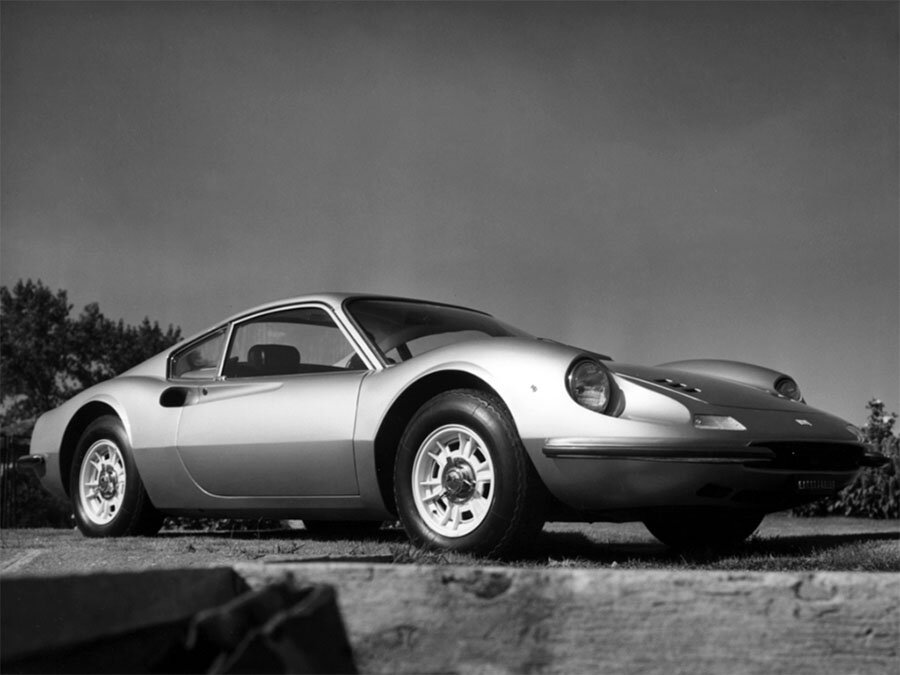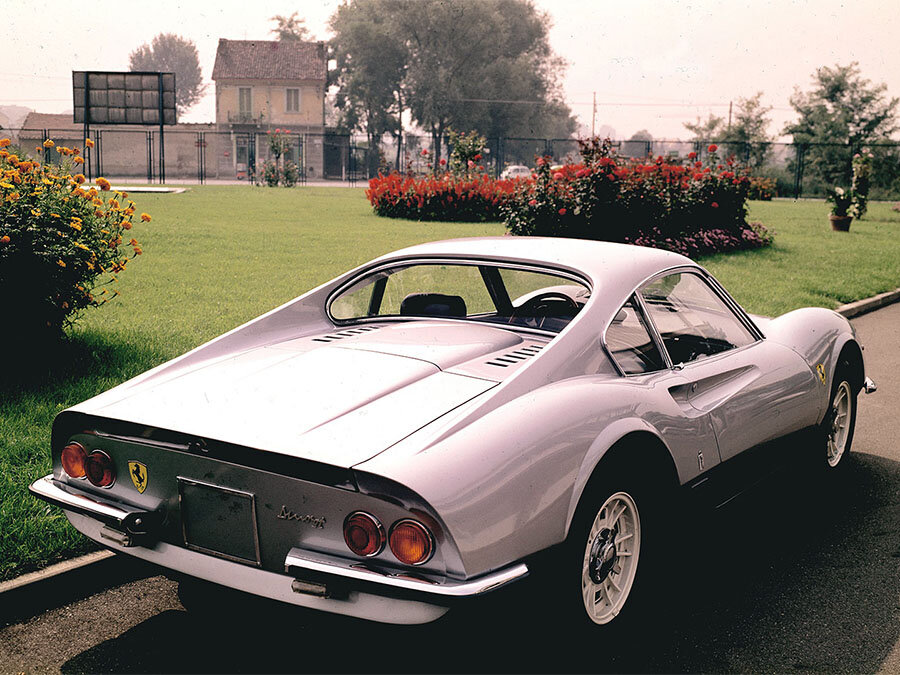Guide: Ferrari Dino 206 GT - a Historical & Technical Appraisal
/BACKGROUND
Having convincingly proposed the benefits of a dual overhead camshaft 65° V6 to his father in the mid 1950s, Enzo Ferrari’s son, Alfredo, died from muscular dystrophy in 1956 before the new Vittorio Jano-designed engine came to fruition.
Alfredo was more widely known as Dino and it was this nickname that his father chose to grace certain V6-powered Ferraris thereafter.
In the years that followed, Dino engines were successfully used in Formula 1, Formula 2 and Sports racing cars.
In early 1965, the FIA announced that new Formula 2 regulations would come into effect from 1967. The principle rule change concerned engines: there would be a 1600cc, six cylinder limit and minimum production requirement of 500 units. The engine blocks had to be used in 500 road-going production cars built within a twelve month timeframe.
After several years out of Formula 2, Enzo Ferrari wanted to promote his Dino brand in this junior series. At the time, Formula 2 was far more popular than any modern era feeder category. It routinely attracted Formula 1 drivers and manufacturers and the new 1967 regulations were expected to yield a further explosion of interest.
Ferrari already had a 1.6-litre 65° V6 in development for the 1965 Dino 166 P. The engine was subsequently enlarged to 2-litres and achieved considerable success in sports car racing and hillclimbs.
Enzo Ferrari considered his Dino V6 engine the perfect basis for a 1600cc F2 powerplant.
However, Ferrari did not have the production capacity to make the 500 road cars required in a twelve month period. As a result, the company turned to Fiat. In March 1965, the two firms signed a cooperation agreement that would see Fiat produce the V6-powered Dino range in sufficient numbers to allow Ferrari to go racing with their new Formula 2 car.
One of the prototype Dino engines was sent to Fiat whose engineers stripped it down and reconfigured it to suit mass production methods.
Fiat and Ferrari then set about designing new cars to take the engine.
Fiat came up with two models: the Dino Spider (with bodywork by Pininfarina) and the Dino Coupe (with bodywork by Bertone). Ferrari conceived the Dino GT (another Pininfarina design).
All three models were initially built with the V6 Dino block enlarged to two-litres.
Ferrari’s first Dino road car concept was displayed at the Paris Motor Show in October 1965. Based on a 206 S sports racing platform, the stunning Ferrari Dino 206 Pininfarina Berlinetta Speciale constructed on chassis 0840 previewed a host of styling cues that would subsequently be adopted.
The first prototype of a true production Dino GT appeared at the Turin Motor Show in November 1966. Built on chassis 00106 (depicted above), this diminutive yellow Berlinetta caused a great deal of interest and, over the next twelve months, its features were gradually refined.
Another prototype was displayed at the Turin Motor Show in November 1967. By this time, the Dino GT was close to production-ready.
Deliveries began in the spring of 1968.
The Dino 206 GT joined a Ferrari line up that included the four seat 365 GT, the 330 GTC (a two-seat Coupe) and the 275 GTB/4 (a rakish two-seat Berlinetta). Open versions of the GTC and GTB/4 were also available (the 330 GTS and 275 GTS/4).
CHASSIS
The 206 GT used a brand new tubular steel chassis with a 2280mm wheelbase. Alloy panels were riveted in place to effectively create a semi-monocoque arrangement. The V6 motor was mounted transversely behind the seats; it was Ferrari’s first mid-engined production car.
Suspension was fully independent with unequal length wishbones, coil springs and telescopic Koni dampers. Anti-roll bars were installed at either end.
Disc brakes were fitted at each corner along with 6.5 x 14-inch Cromodora alloy wheels. These were fastened in place with a single triple-eared bolt and originally came shod with Pirelli tyres.
A 65-litre fuel tank was located up against the left-hand side of the rear bulkhead.
The Dino 206 GT was the first Ferrari to use rack and pinion steering.
ENGINE / TRANSMISSION
The original line of Dino engines was credited to Vittorio Jano while its conversion to mass production unit was handled by Aurelio Lampredi. The same engine used in Ferrari’s Dino was also fitted to the Fiat Dinos and these motors were all manufactured on the same Rivalta production line.
A 65° V6 with dual overhead camshafts for each bank of cylinders, the Tipo 135 B 000 engine used an alloy block and head with cast iron wet cylinder liners, cast iron valve seats and hemispherical combustion chambers.
It displaced 1987cc thanks to a bore and stroke of 86mm and 57mm respectively.
Compression was set at 9.0:1 and three twin choke Weber 40 DCN downdraught carburettors were fitted.
Wet-sump lubrication was employed while ignition was via a single spark plug per cylinder and single coil.
Peak output was 160bhp at 7200rpm and 126lb-ft at 6000rpm.
Transmission was via an all-synchromesh five-speed manual gearbox, single plate clutch and limited-slip differential.
BODYWORK
As had been the case for all series production Ferrari models since late 1953, the contract to design bodywork for this latest offering was handed to Pininfarina.
Fabrication was handled by Scaglietti in Modena. Aluminium was used throughout.
The finished article was spectacular and beautiful. It featured curvaceous wings, recessed headlights and delicate bumperettes at each corner. The shallow primary nose intake fed fresh air to the radiator while smaller ducts were cut from the front apron to cool the brakes.
Two banks of vents were mounted on the front lid which lifted up for access to the full size spare wheel.
Visibility out of the glassy cockpit was excellent. Elegant flying buttresses swept down to the Kamm tail. The single-piece rear windscreen was delicately curved, as were the engine cooling scoops carved out from each flank.
Originally there were no Ferrari emblems to be found anywhere on the car.
INTERIOR
The interior was equally well thought out.
All instrumentation was housed in an oval binnacle with a plain aluminium fascia. Large gauges for engine and road speed were flanked by a clock and ammeter. In between the speedometer and rev counter were four small read outs for oil and water temperature, oil pressure and fuel.
The dashboard was upholstered in fine dark grey mousehair to avoid reflections from the windscreen. The steering wheel had a traditional wood rim and three alloy spokes.
Seat centres were trimmed with ribbed fabric in black or red. Black vinyl was used for pretty much everything else.
The steeply raked seats could be adjusted for and aft but the backs were fixed in position and the headrests were mounted on the upholstered upper section of the rear bulkhead.
OPTIONS
Optional extras included Plexiglas headlight covers and full vinyl upholstery.
WEIGHT / PERFORMANCE
Ferrari quoted a dry weight of 900kg, a top speed of 146mph and 0-62mph time of seven seconds.
PRODUCTION
Production began almost immediately after the Brussels Motor Show in February 1968. It ran at the rate of around three cars a week for 18 months.
In August 1969 (after 152 examples had been completed, all of which were left-hand drive) Ferrari dropped the model to make way for a 2.4-litre version with a cast-iron engine block and long wheelbase chassis (the Dino 246 GT).
COMPETITION HISTORY
Although Ferrari never developed the Dino 206 GT as anything but a road-going production model, its wonderful handling and spirited performance convinced Luigi Chinetti to enter one for the Sebring 12 Hours on March 22nd 1969 (round two of the World Sportscar Championship).
Chinetti was the Ferrari importer for the USA and his North American Racing Team (NART) had for many years received a degree of factory assistance.
Chassis 00306 left the factory as a standard Dino 206 GT painted Blu Notte Metallizzato with Plexiglas headlight covers.
As a Prototype class entry (the Dino had not been homologated for the GT category), all manner of modifications would have been permitted such as wider wheels and tyres, additional spoilers and sundry engine upgrades. However, aside from some extra safety equipment (spot lights, a battery cut-off switch, a roll bar and racing harnesses), 00306 was kept remarkably standard.
NART added a white and red centre stripe.
Sam Posey and Bob Dini qualified 29th overall which was quicker than any other two-litre GT car and confirmed that, had homologation requirements been met, the Dino would have made an excellent competition car for the Grand Touring class.
Unfortunately, cooling problems hampered the Dino’s race pace and much time was lost in the pits. Nevertheless, it was still running at the end and was eventually classified in 36th position overall (tenth in the two-litre Prototype class).
Text copyright: Supercar Nostalgia
Photo copyright: Ferrari - https://www.ferrari.com & Pininfarina - https://pininfarina.it



































